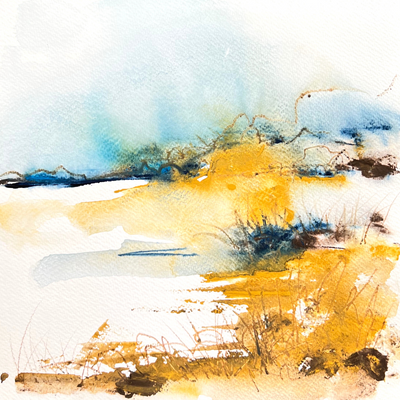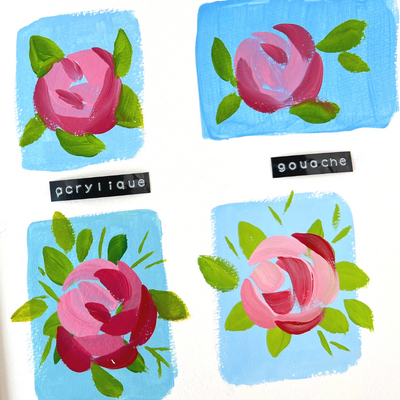Gouache or Tempera? The Guide for Every Artist
Gouache and tempera may seem alike, and some countries use the two words for the same painting. But they are cousins, not sisters! Let’s see the differences between gouache and tempera.
Table of Contents
- Gouache and Tempera: confusing names
- Spotting the Differences between gouache and tempera
- Celebrating the Common Grounds
- In Conclusion: Choosing Your Battles
Gouache and Tempera: confusing names
You may have heard of gouache, tempera, and poster paint. All are pigments in a water-based emulsion with a binder. The differences rely on the binder:
- arabic gum for gouache
- egg yolk for tempera
- casein for poster paint
This is the main binder; brands add more additives to the mix.
It’s confusing when brands and countries use the three words for the same paint. And the price is very different from one country to another. For example, casein paint is costly in France, but poster paint is affordable.
And inside a paint, you have a different range, from student to artist quality.
It’s fascinating how these two terms, referring to distinct types of paint in English, can juggle meanings as we leap from one language to another. For instance, in Italian, “tempera” might often describe what we know as gouache. In contrast, “gouache” in some other languages might refer to something completely different, like poster paint.
But hold on! Before you get dizzy with all this terminological juggling, remember that at the end of the day, names are just names. Whether you call it gouache, tempera, or “that creamy, dreamy paint,” what truly matters is how it helps you bring your artistic vision to life!
I think gouache and poster paint behave almost the same, but not gouache and tempera. So let’s see that.

Spotting the Differences between gouache and tempera
The Peculiarities of Composition
One of the significant contrasts between gouache and tempera lies in their make-up. Gouache uses gum Arabic as its binder, similar to watercolors, but with larger pigment particles and added opaque white.
Tempera, in contrast, has traditionally used an egg yolk (or egg white) base as a binder. This gives each a unique feel—the gouache is rich and smooth, while the tempera provides a velvety, delicate, unforgettable texture.
The Dissimilar Strokes and Techniques
Both gouache and tempera allow for layering, but the process varies. Gouache, forgiving and flexible, allows reworking and blending, even after drying.
Tempera, however, requires a more plan-ahead approach as layers dry quickly and don’t easily blend once dry. It’s like comparing a spirited jam session to a meticulously planned orchestra—each has charm.
The Art of Drying and Workability
Gouache, like a patient old friend, gives you the luxury to adjust strokes and color up to days after laying it down—Add water, and it springs back to life! On the other hand, tempera doesn’t share the same penchant for leisurely contemplation—it tends to dry quickly, adhering to the canvas tenaciously. Your approach would depend on how spontaneous (or planned) you want your artistic process to be.
Beware of Tempera surface.
Tempera has incredible lightfastness, with artworks lasting centuries as proof. However, there’s a little caveat – it’s not super flexible. Just remember to apply it to rigid surfaces to avoid any unfortunate cracking incidents. It’s perfect for frescoes on the wall and wood panels.
Celebrating the Common Grounds
The Shared Versatility
Gouache and tempera may differ significantly, but they’re kindred spirits regarding versatility. Both dance smoothly on various surfaces – paper, canvas, board, walls—you name it! This shared flexibility makes both mediums a joy to work with, expanding the horizons of your artistic journey.
Historical Richness
These two have a storied past, you know? Both gouache and tempera were mediums of choice for many great artists from history. Imagine you’re linked across the ages to masters like Duccio, Botticelli, and ancient Egyptian artists! The illustrious past of these mediums brings such depth to their respective reputations and how we perceive them today.
Vibrant Colors, Matte Finish
When you look at a painting, the vibrant colors captivate you first. The good news is that gouache and tempera offer an impressive color payout. They dry to a stunning matte finish, lend an enchanting depth to the painting, and magnetize its overall mood.
In Conclusion: Choosing Your Battles
Both gouache and tempera are exceptional mediums with unique quirks and strengths. Your choice depends mainly on your desired workflow, painting technique, and aesthetic preferences.
For instance, if you love the flow of watercolors but crave more opacity, gouache might be your spirit medium. If you’re excited by the challenge of planning out your layers and admire a delicate, matte aesthetic, tempera could be your go-to.
So, are you ready to dive deeper into the world of art with tempera and gouache? Give both a go! Each medium is ready to welcome you into its distinctive world, offering engaging experiences, creative opportunities, and lessons. And remember, whichever you choose, take joy in creating because, in art, the journey is as enchanting as the result.
Happy painting!






